The global pine bark extracts market is projected to grow from USD 1,250.3 million in 2025 to approximately USD 4,060.1 million by 2035, recording an absolute increase of USD 2,809.3 million over the forecast period. This translates into a total growth of 225.8%, with the market forecast to expand at a compound annual growth rate (CAGR) of 12.5% between 2025 and 2035. The overall market size is expected to grow by nearly 3.26X during the same period, supported by the rising adoption of natural skincare solutions and increasing consumer awareness about the antioxidant benefits of pine bark extracts.

Between 2025 and 2030, the pine bark extracts market is projected to expand from USD 1,250.3 million to USD 2,251.1 million, resulting in a value increase of USD 1,007.5 million, which represents 35.9% of the total forecast growth for the decade. This phase of growth will be shaped by rising penetration of natural skincare products in global beauty markets, increasing consumer preference for clean-label formulations, and growing awareness among consumers about the anti-aging benefits of pine bark extracts. Manufacturers are expanding their product portfolios to address the growing complexity of modern skincare needs and premium positioning strategies.
From 2030 to 2035, the market is forecast to grow from USD 2,251.1 million to USD 4,060.1 million, adding another USD 1,801.8 million, which constitutes 64.1% of the overall ten-year expansion. This period is expected to be characterized by expansion of e-commerce distribution channels, integration of advanced extraction technologies, and development of standardized quality protocols across different product manufacturers. The growing adoption of nutricosmetics and personalized skincare solutions will drive demand for more sophisticated pine bark extract formulations and specialized product variants.
Between 2020 and 2025, the pine bark extracts market experienced rapid expansion, driven by increasing consumer awareness of natural antioxidants and growing demand for anti-aging skincare solutions. The market developed as beauty and personal care companies recognized the efficacy of pine bark extracts in addressing skin concerns related to aging, UV damage, and environmental stressors. Health-conscious consumers and dermatologists began emphasizing the importance of natural ingredients with proven scientific backing for long-term skin health benefits.
| Metric | Value |
|---|---|
| Estimated Value in (2025E) | USD 1,250.3 million |
| Forecast Value in (2035F) | USD 4,060.1 million |
| Forecast CAGR (2025 to 2035) | 12.5% |
Market expansion is being supported by the rapid increase in consumer preference for natural and organic skincare products worldwide and the corresponding need for clinically proven ingredients that deliver visible results. Modern consumers are increasingly seeking products with antioxidant properties that can protect against environmental damage and support healthy aging. The growing body of scientific research supporting the efficacy of pine bark extracts in skincare applications is driving adoption across multiple product categories and consumer segments.
The growing complexity of skincare routines and increasing awareness of ingredient transparency are driving demand for premium natural extracts from certified suppliers with appropriate quality standards and sustainable sourcing practices. Beauty influencers and dermatologists are increasingly recommending products with pine bark extracts for their proven anti-inflammatory and antioxidant properties. Regulatory acceptance and clinical validation are establishing standardized extraction and formulation procedures that require specialized processing capabilities and quality assurance protocols.
The market is segmented by function, product type, claim, distribution channel, and region. By function, the market is divided into antioxidant & anti-aging, skin brightening, UV protection, and repair & barrier strengthening. Based on product type, the market is categorized into serums, creams/lotions, capsules/nutricosmetics, masks, and others. In terms of claims, the market is segmented into natural/organic, vegan, clean-label, clinically proven, and others. By distribution channel, the market is classified into e-commerce, pharmacies, specialty beauty retail, and mass retail. Regionally, the market is divided into North America, Europe, East Asia, South Asia & Pacific, Latin America, and Middle East & Africa.
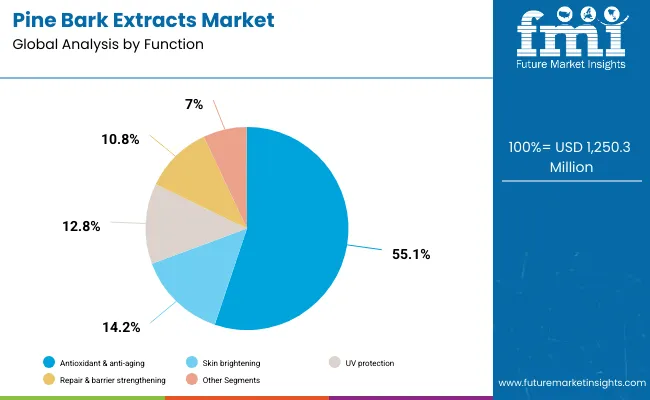
The antioxidant & anti-aging function is projected to account for 55.1% of the pine bark extracts market in 2025, underscoring its leadership as the category’s primary application. Pine bark extract, rich in oligomeric proanthocyanidins (OPCs), delivers powerful antioxidant activity that combats oxidative stress, neutralizes free radicals, and protects skin from environmental aggressors such as UV radiation and pollution.
These properties support collagen stabilization and improved skin elasticity, addressing visible signs of aging including fine lines and uneven texture. Consumer awareness of antioxidants’ role in both prevention and repair continues to expand, fueled by dermatological research and marketing campaigns highlighting “defense against premature aging.” Growing lifestyle concerns about pollution-induced skin damage further elevate the relevance of pine bark extracts. With a strong scientific foundation and clear alignment with global anti-aging trends, this segment is positioned to maintain its dominance and drive future market expansion.
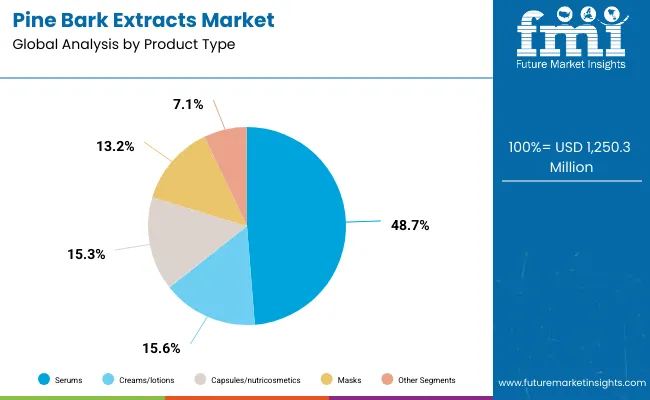
Serums are projected to account for 48.7% of pine bark extract product demand in 2025, reflecting their position as the preferred format for concentrated, high-performance skincare. Serums enable higher concentrations of pine bark actives, ensuring deeper skin penetration and faster results compared to creams or lotions. Consumers increasingly turn to serums for targeted benefits, particularly in anti-aging routines where efficacy and visible improvements are key decision drivers.
The category benefits from strong premium positioning, with pine bark serums often marketed as advanced or clinical-grade solutions. Innovations combining pine bark extract with complementary actives like Vitamin C or hyaluronic acid are further amplifying consumer interest. With rising adoption of multi-step skincare routines and growing willingness to invest in potent treatments, serums are set to remain the anchor format for pine bark extract formulations, commanding higher margins and consumer trust.
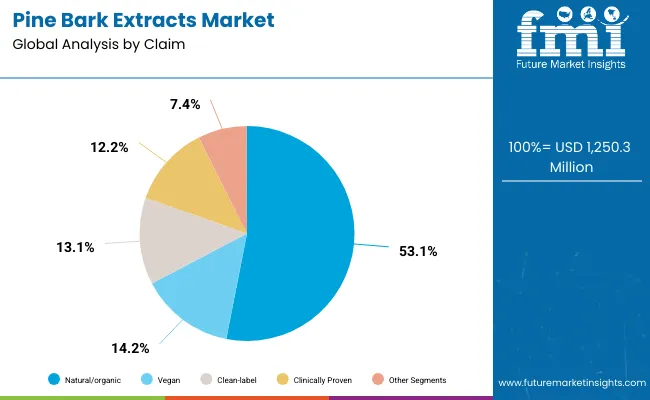
The natural/organic claim is projected to account for 53.1% of the pine bark extracts market in 2025, reflecting the growing convergence of efficacy, safety, and sustainability in consumer purchasing choices. Pine bark extracts, derived from natural plant sources, align seamlessly with clean beauty values, making them ideal for organic-certified and naturally positioned formulations. Health-conscious consumers increasingly demand transparency in ingredient sourcing and assurance that products are free from synthetic additives, parabens, or harmful chemicals.
This trend is reinforced by stricter regulatory frameworks governing organic labeling, particularly in North America and Europe, which further validate brand claims. Natural/organic positioning also enables premium price strategies, as consumers perceive these products as safer, gentler, and more environmentally responsible. As ethical and eco-conscious beauty gains global traction, natural/organic pine bark extract products will remain central to sustaining consumer loyalty and brand differentiation.
The pine bark extracts market is advancing rapidly due to increasing consumer awareness of natural antioxidants and growing recognition of their skincare benefits. However, the market faces challenges including high raw material costs, need for consistent quality standards across suppliers, and varying extraction methods that can affect product efficacy. Standardization efforts and clinical validation studies continue to influence product development and market acceptance patterns.
The growing deployment of e-commerce platforms is enabling direct-to-consumer sales and personalized product recommendations based on individual skin concerns and preferences. Digital marketing strategies and influencer partnerships are educating consumers about the benefits of pine bark extracts while building brand awareness and loyalty. These channels are particularly valuable for premium brands and specialized formulations that require detailed product education and targeted consumer outreach.
Modern manufacturers are incorporating advanced extraction methods and stabilization technologies that improve bioavailability and extend shelf life of pine bark extract formulations. Integration of nanotechnology and encapsulation systems enables more effective delivery of active compounds and enhanced product performance. Advanced processing also supports the development of standardized extract concentrations and quality specifications that ensure consistent product efficacy.
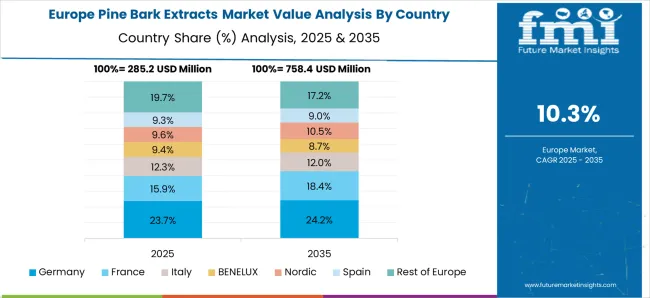
The pine bark extracts market in Europe demonstrates sophisticated development across major economies with Germany showing strong presence through its advanced phytochemical research capabilities and consumer appreciation for clinically-validated botanical ingredients, supported by companies like Bioforce leveraging traditional herbal knowledge combined with modern extraction technologies to develop high-quality pine bark supplements and cosmetic applications.
France represents a significant market driven by its expertise in botanical extraction and luxury skincare formulations, with companies like Givaudan pioneering innovative pine bark extract applications that combine French botanical artistry with advanced antioxidant delivery systems for premium anti-aging and protective skincare solutions.
Switzerland contributes through companies like Horphag Research, which developed the renowned Pycnogenol standardized pine bark extract, establishing global quality standards and clinical validation for pine bark applications in both nutraceutical and cosmetic industries. Spain shows growing interest through companies like ISDIN incorporating pine bark extracts in dermatological and sun protection products.
Italy and other European regions exhibit expanding demand for antioxidant-rich botanical extracts, while Eastern Europe and Nordic regions display emerging potential, driven by traditional knowledge of pine-based remedies and growing consumer awareness of natural antioxidant benefits.

South Korea represents an emerging innovation center for pine bark extracts, positioning as a growing global market with health-conscious consumers increasingly embracing antioxidant-rich botanical ingredients and traditional plant-based wellness solutions. The market benefits from extensive research capabilities in botanical extraction and fermentation technologies, creating natural advantages for developing advanced pine bark processing techniques and novel delivery systems. Strong domestic biotechnology infrastructure and cosmetics manufacturing capabilities support both local consumption and export opportunities to global markets.
The integration of pine bark extracts with Korean expertise in fermented ingredients and bioprocessing, combined with traditional knowledge of pine-based remedies in Asian wellness practices, positions the market as both an important consumer base and emerging innovation catalyst. Consumer sophistication in understanding antioxidant benefits and long-term health approaches, along with the growing K-beauty influence on global skincare trends, supports the development of pine bark extract applications in both nutraceutical and cosmetic industries worldwide.

| Country | CAGR (2025 to 2035) |
|---|---|
| India | 23.8% |
| China | 20.5% |
| Japan | 17.5% |
| UK | 13.2% |
| Germany | 10.5% |
| USA | 9.3% |
The pine bark extracts market is experiencing robust growth globally, with India leading at a 23.8% CAGR through 2035, driven by rapidly expanding middle-class population, increasing disposable income, and growing awareness of premium skincare products. China follows at 20.5%, supported by strong e-commerce infrastructure, rising beauty consciousness, and preference for natural ingredients in cosmetics.
Japan grows steadily at 17.5%, emphasizing quality, innovation, and premium product positioning. The UK records 13.2%, focusing on clean beauty trends and organic certification. Germany shows 10.5% growth, emphasizing scientific validation and quality standards. The USA demonstrates steady expansion at 9.3%, driven by mature market dynamics and brand diversification strategies. The report covers an in-depth analysis of 40+ countries; six top-performing OECD countries are highlighted below.
Revenue from Pine Bark Extracts in India is projected to exhibit the highest growth rate with a CAGR of 23.8% through 2035, driven by rapid expansion of the middle-class population and increasing consumer spending on premium skincare products. The country's growing awareness of natural and organic beauty solutions is creating significant demand for scientifically-backed botanical extracts. Major international and domestic beauty brands are establishing comprehensive distribution networks to serve the expanding urban consumer base seeking advanced anti-aging solutions.
Revenue from Pine Bark Extracts in China is expanding at a CAGR of 20.5%, supported by sophisticated e-commerce infrastructure and growing consumer preference for premium international beauty brands. The country's established digital marketing ecosystem and influencer culture are driving awareness and adoption of specialized skincare ingredients. Domestic and international manufacturers are leveraging online platforms and social commerce to reach diverse consumer segments across tier-1 and tier-2 cities.
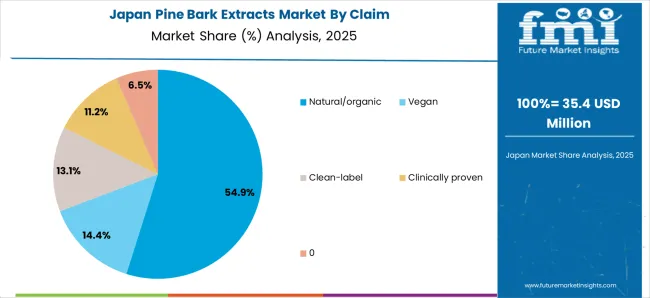
Revenue from Pine Bark Extracts in Japan is growing at a CAGR of 17.5%, driven by strong consumer preference for high-quality, scientifically-validated skincare ingredients and willingness to invest in premium anti-aging solutions. The country's sophisticated beauty market emphasizes product efficacy, innovative formulations, and meticulous quality standards. Japanese consumers demonstrate high brand loyalty and appreciation for products with proven clinical benefits and superior sensory experiences.
Demand for Pine Bark Extracts in the UK is projected to grow at a CAGR of 13.2%, supported by strong consumer preference for clean beauty products and increasing emphasis on ingredient transparency and sustainability. British consumers are increasingly seeking products with verified organic certification and ethical sourcing practices. The market is characterized by focus on environmental responsibility, premium natural ingredients, and compliance with stringent regulatory standards for cosmetic products.
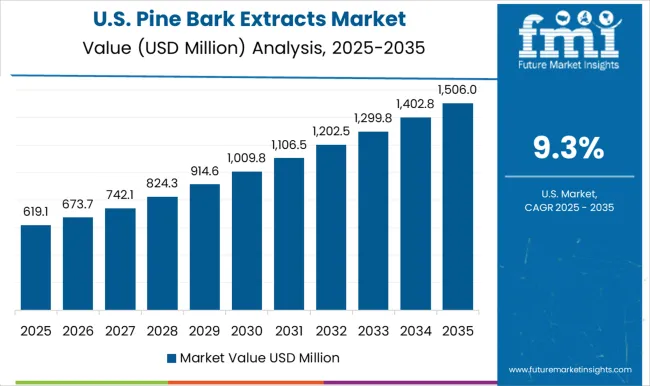
Demand for Pine Bark Extracts in the USA is expanding at a CAGR of 9.3%, driven by established consumer awareness of antioxidant skincare benefits and mature distribution channels across multiple retail formats. American consumers demonstrate sophisticated understanding of skincare ingredients and seek products with clinical validation and dermatologist recommendations. The market benefits from comprehensive regulatory frameworks and established quality standards that support consumer confidence and product efficacy claims.
Revenue from pine bark extracts in Germany is projected to grow at a CAGR of 10.5% through 2035, supported by the country’s strong emphasis on scientifically validated natural ingredients and rising consumer demand for premium botanical skincare solutions. German consumers prioritize safety, efficacy, and sustainability, positioning pine bark extract as a preferred ingredient in anti-aging and skin-repair formulations.
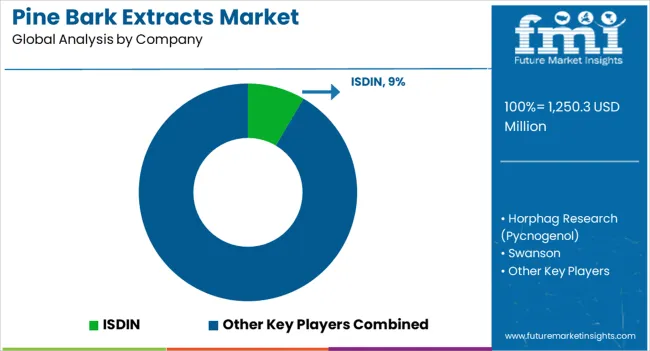
The pine bark extracts market is defined by competition among specialized ingredient suppliers, established beauty brands, and emerging clean beauty companies. Companies are investing in advanced extraction technologies, clinical validation studies, sustainable sourcing practices, and innovative formulation capabilities to deliver effective, safe, and environmentally responsible products. Strategic partnerships, scientific research, and geographic expansion are central to strengthening product portfolios and market presence.
ISDIN leads the global market with an 8.5% share in 2025, while other players collectively account for 91.5% of the market. The competitive landscape includes Horphag Research (Pycnogenol) with proprietary extraction technology and extensive clinical research, Swanson offering comprehensive natural health products, and Now Foods providing accessible natural supplements. Givaudan delivers advanced ingredient solutions for cosmetic applications, while Nature's Way, Twinlab, Solgar, Bioforce, Life Extension, and Pure Encapsulations offer specialized formulations across various consumer segments and distribution channels.
| Items | Values |
|---|---|
| Quantitative Units (2025) | USD 1,243.6 Million |
| Function | Antioxidant & anti-aging, Skin brightening, UV protection, Repair & barrier strengthening |
| Product Type | Serums, Creams/lotions, Capsules/nutricosmetics, Masks, Others |
| Claim | Natural/organic, Vegan, Clean-label, Clinically proven, Others |
| Distribution Channel | E-commerce, Pharmacies, Specialty beauty retail, Mass retail |
| Regions Covered | North America, Europe, East Asia, South Asia & Pacific, Latin America, Middle East & Africa |
| Countries Covered | United States, Canada, United Kingdom, Germany, France, China, Japan, South Korea, Brazil, India, Australia and 40+ countries |
| Key Companies Profiled | Horphag Research (Pycnogenol), Swanson, Now Foods, Givaudan, Nature's Way, Twinlab, Solgar, Bioforce, Life Extension, Pure Encapsulations, ISDIN |
| Additional Attributes | Dollar sales by extract type and concentration level, regional demand trends, competitive landscape, buyer preferences for capsule versus liquid formats, integration with clean-label/antioxidant positioning, innovations in standardized extraction, bioavailability enhancement, and sustainable sourcing practices |
The global pine bark extracts market is estimated to be valued at USD 1,250.3 million in 2025.
The market size for the pine bark extracts market is projected to reach USD 4,060.1 million by 2035.
The pine bark extracts market is expected to grow at a 12.5% CAGR between 2025 and 2035.
The key product types in pine bark extracts market are natural/organic, vegan, clean-label, clinically proven and other segments.
In terms of function, antioxidant & anti-aging segment to command 55.1% share in the pine bark extracts market in 2025.






Full Research Suite comprises of:
Market outlook & trends analysis
Interviews & case studies
Strategic recommendations
Vendor profiles & capabilities analysis
5-year forecasts
8 regions and 60+ country-level data splits
Market segment data splits
12 months of continuous data updates
DELIVERED AS:
PDF EXCEL ONLINE
Analysis and Growth Projections for Pine-derived Chemicals Market
Spine Pain Market Size and Share Forecast Outlook 2025 to 2035
Spine Biologics Market Size and Share Forecast Outlook 2025 to 2035
Epinephrine Auto-Injectors Market Insights - Growth & Forecast 2024 to 2034
Spine Positioning Devices Market
Lupine Peptides Market Size and Share Forecast Outlook 2025 to 2035
Philippines Tourism Industry Forecast Outlook 2025 to 2035
Philippines Culinary Tourism Market Analysis – Growth & Forecast 2025 to 2035
Efonidipine Hydrochloride Market Size and Share Forecast Outlook 2025 to 2035
Cervical Spine System Market – Innovations, Trends & Forecast 2025 to 2035
United States Spine Pain Market Trend Analysis Based on Product, Pain, End-User, and Regions 2025 to 2035
Non-Operative Spine Care Market
Dopamine and Norepinephrine Reuptake Inhibitor Market
Minimally Invasive Spine Technologies Market Size and Share Forecast Outlook 2025 to 2035
Injectable Benzodiazepine Market – Trends, Growth & Forecast 2022-2032
Excessive Daytime Sleepiness Market Insights – Trends, Growth & Forecast 2025 to 2035
Pygeum Bark Extract Market
Massoia Bark Essential Oil Market Size and Share Forecast Outlook 2025 to 2035
Extracts and Distillates Market
Meat Extracts Market Size and Share Forecast Outlook 2025 to 2035

Thank you!
You will receive an email from our Business Development Manager. Please be sure to check your SPAM/JUNK folder too.
Chat With
MaRIA